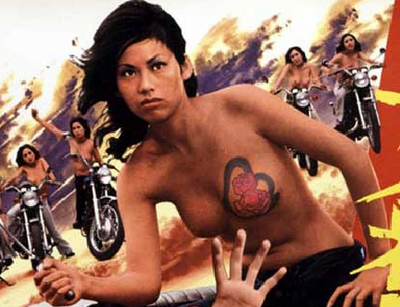 One Friday in June I went to Viz Cinema to see TokyoScope Talk Vol. 4: Hot Tears of Shame.
One Friday in June I went to Viz Cinema to see TokyoScope Talk Vol. 4: Hot Tears of Shame. From naughty hot spring geisha, to S&M-addicted salarymen, to the latest bizarre innovations in adult video, this pulse-pounding presentation will shamelessly reveal the history of “gettin’ it on” in Japanese cinema. Join hosts Patrick Macias and Tomohiro Machiyama as they sift through the wreckage of Roman Porno, Pinky Violence, and AV in search of the most mind-blowing scenes ever to emerge from the Land of the Rising Sun.
Macias would show some photos and film clips from a laptop that was patched into the theater's projection system. Machiyama would add some Japanese perspective. Including a humorous if not potential tragic encounter during his first trip a pinku eiga theater.
A few of the highlights from the presentation. The talk focused Pink Films or Pinku Eiga; that is soft-core films that evolved into something akin to American grindhouse or exploitation. Most of the presentation dealt with post-WWII films and trends. SCAP (I knew that acronym without having to look it up) established the censorship laws during the occupation and although the laws have been repealed, the practices continue because they've become part of the genre. The most obvious restrictions are that the male genitalia, penetration and ejaculation cannot be shown on screen. This frequently results in a black bar or fuzzy dot that blocks the offensive act. As time wore on, some filmmakers became adept at using camera angles and "blocking" the action so that the post-editing would be needed. The opening title sequence of Austin Powers: The Spy Who Shagged Me would be an American example of this kind of filmmaking technique.
The first adult films after the war to be considered pink were made in the late 1950s and early 1960s by independent directors. These were typically low budget affairs that served to push the boundaries. By the late 1960s, as pinku eiga found more success, major Japanese film studios began setting up pink subsidiaries to make those kinds of film. It was then that "pinky violence" begins to show up. In these films, a female protagonist will typically extract violent revenge for past indignities and injustices. "Roman porno" also originated in this period and is short for "Romance" or "Romantic." These film focused on the sex lives of the common woman - sexually frustrated housewife types.
 In addition to the history of pinku eiga, Macias and Machiyama mentioned some films that are now on my "to see" list. The most interesting is Zero Woman: Red Handcuffs (1974) with Miki Sugimoto. Actually, Sugimot's whole filmography looks like a Pinky Violence All-Time list: Criminal Woman: Killing Melody, Terrifying Girls' High School: Lynch Law Classroom, Girl Boss: Escape From Reform School and Girl Boss Guerilla .
In addition to the history of pinku eiga, Macias and Machiyama mentioned some films that are now on my "to see" list. The most interesting is Zero Woman: Red Handcuffs (1974) with Miki Sugimoto. Actually, Sugimot's whole filmography looks like a Pinky Violence All-Time list: Criminal Woman: Killing Melody, Terrifying Girls' High School: Lynch Law Classroom, Girl Boss: Escape From Reform School and Girl Boss Guerilla .§§§
 The TokyoScope talk I went to was well attended. In fact, it was the most well-attended event I've been to at Viz. The next TokyoScope talk is on July 9 and titled Vol. 5 Japanese Superheroes. The talk is at 7 PM at New People/Viz. July 9 is during the Another Hole in the Head film festival so I'm not sure if I'm going to go.
The TokyoScope talk I went to was well attended. In fact, it was the most well-attended event I've been to at Viz. The next TokyoScope talk is on July 9 and titled Vol. 5 Japanese Superheroes. The talk is at 7 PM at New People/Viz. July 9 is during the Another Hole in the Head film festival so I'm not sure if I'm going to go.Ultraman! Kamen Rider! The Power Rangers! These and many other colorful crusaders of justice are now recognized the world over as essential icons of Japanese pop culture. But where did they come from? Who created them? And what is it really like battling rubber monsters and the forces of evil on a regular basis? Join hosts Patrick Macias (editor, Otaku USA magazine), August Ragone (author, Eiji Tsuburaya: Master of Monsters), and Tomohiro Machiyama (founding editor, Movie Treasures) as they explore the fascinating history and origins of Japanese superheroes using

 magazine, rare film clips and images from numerous tokusatsu, sentai, and henshinhero productions including Ultra Seven, Kikaida, Space Sheriff Gavan, and many others.
magazine, rare film clips and images from numerous tokusatsu, sentai, and henshinhero productions including Ultra Seven, Kikaida, Space Sheriff Gavan, and many others.When I was a boy, I lived in Hawaii. In the 1970s they would show Kikaida and Kamen Rider on television. By the way, I think the guy in the green shirt in the Vol. 4 poster and the motorcycle riding guitarist (Kikaida reference) in the Vol. 5 poster is Patrick Macias. Do you see a resemblance? Speaking of resemblances, do you think Macias looks like Javier Bardem from No Country for Old Men?
§§§
As of July 3, I've seen 191 films in 2010 at an average cost of $7.27/film.



No comments:
Post a Comment